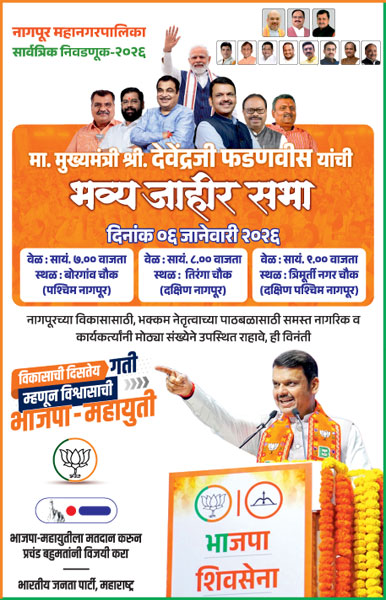
Nagpur: The Board of Trustees of Nagpur Improvement Trust finally approved the long-awaited Nagpur Metropolitan Region Development plan with minor modifications in tune with the hundreds of suggestions and objections put up by people. The plan will now be sent to State Government for final approval. The total estimated cost of infrastructure development of Metropolitan Region is Rs 37,000 crore. The area covered under Metro Region is 3,567 sq kms, spread over 721 villages of 9 tehsils of Nagpur District.
NIT Chairman Dr Deepak Mhaisekar presided over the meeting of Board of Trustees on June 21. Standing Committee Chairman Sudhir Raut, NIT Trustee Bhushan Shingne, Municipal Commissioner Shravan Hardikar, Joint Director Town Planning Adhari, and Chief Engineer Sunil Gujjalwar were present in the meeting. The high power committee submitted the plan to the NIT after completing the hearing on more than 6,649 suggestions and objections by March 17, 2016. Several gram panchayats, farmers, NGOs opposed the draft plan as according to them it covers almost 80 kms distance of the district while it has mandate of 25 kms only. The 50 per cent objections related to user change, 25 per cent related to cancellation of reservation, 9 per cent against proposed road network, 1 per cent against Development Control Rules (DCR). NIT will publish a government notification before submitting it to the State Government.
The Director of Town Planning, Pune, has extended final deadline to submit the plan up to August 25, 2016. The Board of Trustees have given authority to NIT Chairman to take final decision over the plan. The plan will be helpful in planned development of the Metro Region area. Since the past few years, the urban growth has expanded beyond the city’s municipal limits. This rapid growth has presented challenges for the future growth of the city and its fringes in an organised manner.
This Draft Development Plan Report is intended to serve as a blueprint for implementing land use and infrastructure proposals in the NMDA for a 20 year period from 2012 to 2032. The process has been done with the latest mapping technology using satellite imagery and the geographical information systems (GIS) platform. This can pave way for the development of new Nagpur in the vicinity of orange city with all basic amenities and world class infrastructure. This will also promote industrialization, transportation, convention centre, parks, residential area, logistic hub, commercial area, integrated roads, bus terminus and road network. The NIT will generate funds through transfer of development rights, accommodation reservations and public private partnership (PPP) module. As per draft development plan, around 10.3 lakh people reside in the NMRD area as per the data released by Census in 2011. As compared to other cities in the country the present migration rate is found to be relatively low (6-8%) in this area. About 58 percent of the work force is employed in agriculture sector. The tertiary sector employs roughly 40 percent of the total work force in the NMRD. The predominant industrial areas are Multimodal International Hub Airport at Nagpur (MIHAN)and MIDC Industrial Estates in Butibori, Hingna, Umred and Kalmeshwar. The plan has suggested for clustering industrial activities for better, efficient for infrastructure provision and better opportunities for developing synergies between industries. Thus majority growth will mainly occur close to employment centers — MIHAN, Butibori, Hingna, areas located close to the city within the Outer Ring Road; and along main transportation corridors — Wardha Road (NH-7), Amravati Road and Bhandara Road (NH-6). Over 70 per cent (about 12 lakh) of the total projected population of 17 lakhs is expected to be located in urban areas and remaining in rural areas.
Fundamentally there are three working components of the vision – Development and integration of urban systems, economic growth, and environmental and natural resource stewardship. 514 villages have less than 1,000 population. NMDA has 700 villages and 24urban areas. Out of the total habited villages, 73 percent (514) villages have population less than 1,000. 17 percent (117) villages have population between 1,001 and 2,000, 7 percent (51) have population between 2,001 and 5,000, 2 percent (15) have population between 5,001 and 10,000 and3villages have population of 10,000 and above. Analysis across tehsils reveals that, apart from Saoner, all other tehsils have more than60percentof villages with population less than 1,000. Only one village each in Nagpur Rural and Parsheoni has population of 10,000 and above. Of the 24 urban areas, 16 have a population of over 10,000, while 6 have a population of between 5,000 and 10,000 while 2 areas have a population of between 2,000 and 5,000. Hingna, MIHAN, Butibori are employment hubs.













